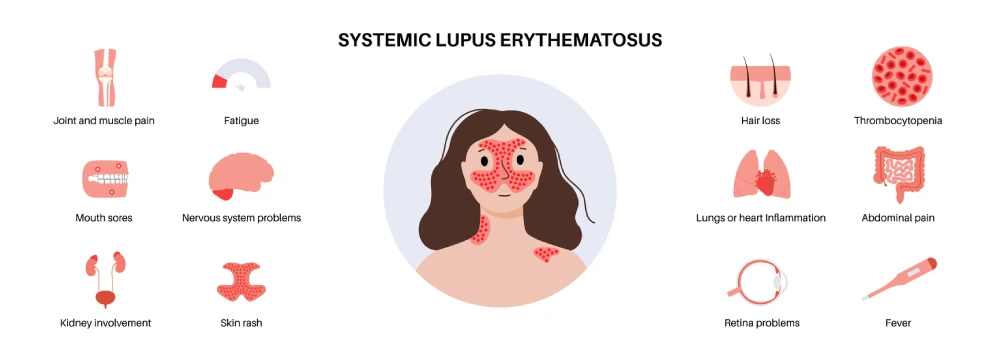It often starts with something small; a stubborn rash, an unexplained wave of fatigue, or joints that ache for no clear reason.
For some, these seemingly random symptoms may be the early signs of lupus, a complex autoimmune disease that can affect nearly every part of the body.
The challenge is, lupus doesn’t present the same way in everyone, and that makes early detection tricky.
Understanding early lupus symptoms is key to managing this lifelong condition effectively and protecting long-term health. With timely diagnosis and the right care, many people living with lupus can lead full, active lives.
In this article, we’ll walk you through common lupus symptoms, the four different types of the disease, what to watch for, and when to speak with a healthcare provider.
Understanding Lupus – Definition, Statistics & Types of Lupus
The Canadian Spondyloarthritis Association defines lupus as a chronic autoimmune disease where the immune system attacks its own tissue.
The cause isn’t fully understood, but it’s believed to result from a combination of genetics, hormones, and environmental triggers.
According to Lupus Canada, lupus affects an estimated 1 in 1,000 Canadians between the ages of 15 and 45, with women being eight times more likely to be diagnosed.
This disease can present in a wide variety of ways, capable of targeting any tissue or organ in the body, making it difficult to diagnose. And with four different types, diagnosis can become even more challenging.
Different Types of Lupus
So, what are the different types of lupus, and how do they vary?
- Systemic Lupus Erythematosus (SLE): is the most common type and frequently the one talked about. SLE can involve multiple organ systems including the skin, joints, kidneys, heart, lungs, and brain.
- Cutaneous Lupus: includes two subtypes, discoid lupus erythematosus (DLE), and subacute cutaneous lupus (SCLE). This type of lupus primarily affects the skin, may or may not have systemic involvement and features sun sensitivity and skin rashes as the primary struggles.
- Drug-induced Lupus: a temporary form of lupus triggered by certain medications. It typically resolves once the offending medication is stopped.
- Neonatal lupus: though rare, this type of lupus occurs in infants born to mothers with subacute cutaneous lupus who also have a specific antibody in their bloodstream.

Lupus Symptoms – Early Signs
The early signs of lupus can be subtle and are often mistaken for other conditions.
Symptoms can fall into numerous categories, such as neurological, cognitive, gastrointestinal, and many more.
Before we look at those specific elements, let’s first explore some of the most common lupus symptoms.
Common Signs of Lupus
- Fatigue is one of the most common and debilitating early symptoms. This isn’t just feeling tired after a long day—this is persistent, overwhelming exhaustion that can interfere with daily tasks and doesn’t improve with rest.
- Joint and muscle pain is another hallmark of lupus. Many people experience stiffness, swelling, and pain, particularly in the hands, wrists, and knees. This can mimic arthritis, leading to delays in diagnosis. Morning stiffness lasting more than 30 minutes is particularly characteristic.
- Skin manifestations are also common and may appear as a butterfly rash, a red or purplish rash that spreads across the cheeks and bridge of the nose. Another common skin-related symptom is photosensitivity, where even short sun exposure can lead to rashes, redness, or flare-ups.
Other visible signs may include hair loss, ulcers or sores inside the mouth or nose, which may recur, or Raynaud’s phenomenon, where fingers and toes turn white or blue in response to cold or stress.
Lastly, some individuals may experience low-grade fevers without a known cause.
These symptoms may be the body’s early warning signs and should never be dismissed.
Now let’s look at some of the other potential symptoms faced by those with lupus.
Neurological and Psychological Symptoms
Lupus can impact the central nervous system, leading to neurological and psychological symptoms that often go unrecognized.
- Headaches, especially migraines or persistent tension-type headaches, are frequently reported and may not respond to typical treatments.
- Cognitive dysfunction, sometimes called “lupus fog,” is another major complaint. People describe difficulty with memory, concentration, and clear thinking. This can affect school, work, and daily decision-making and can be especially distressing when it interferes with independence.
According to Cleveland Clinic, in some cases, mood disorders like depression can even emerge.
These symptoms deserve the same attention and care as physical ones, as mental well-being is crucial to overall lupus management.
Cardiopulmonary (Heart & Lung) Symptoms
Because lupus is a widespread disease that can affect nearly any tissue in the body, it can cause inflammation in the heart and lungs, leading to symptoms that range from mild to severe.
- Chest pain is a common complaint and can manifest as a sharp or stabbing pain, often worsening with deep breaths.
- Shortness of breath may occur due to lung inflammation, fluid buildup, or pulmonary hypertension. For some, this symptom develops gradually, while others may experience it acutely during flare-ups.
Heart and lung involvement is a serious concern in lupus patients.
Mayo Clinic explains that if inflammation in the chest occurs, pneumonia or bleeding into the lungs becomes a risk, while inflammation of the heart, its arteries or the lining around it can increase the risk of cardiovascular disease and heart attacks.
Regular monitoring through imaging and blood work is often necessary to catch these issues early.
Renal Symptoms
One of the most serious complications of lupus is kidney involvement, known as lupus nephritis.
This condition occurs when lupus causes inflammation in the kidneys, impairing their ability to filter waste from the blood. Symptoms can include swelling in the face, legs or feet, foamy or dark-coloured urine, and high blood pressure.
The presence of protein in the urine is often one of the earliest signs of kidney damage however it can go unnoticed without routine urine testing. This makes regular monitoring crucial for people with lupus.
Gastrointestinal Symptoms
Though not as common, lupus can affect the digestive tract, leading to abdominal pain, cramping, or discomfort. This can result from inflammation in the lining of the stomach or intestines.
Nausea and vomiting may be linked to lupus flare-ups, gastrointestinal involvement, or reactions to medications such as corticosteroids or immunosuppressants.
Managing these symptoms often involves adjusting treatment plans in consultation with a healthcare provider.
Hematological (Blood) Symptoms
Lupus can affect blood cells, leading to a variety of abnormalities such as:
- Anemia, or a reduction in red blood cells which may cause fatigue, weakness, and shortness of breath.
- A decreased white blood cell that can make the body more susceptible to infections.
- A low platelet count which can increase the risk of bruising and prolonged bleeding.
These complications highlight the need for regular blood work to monitor changes that might not be visible but are clinically significant.
Reproductive Health and Lupus
Beyond these various symptoms, lupus can have a significant impact on reproductive health. Pregnancy in people with lupus requires careful planning and monitoring, as there’s an increased risk of complications such as preeclampsia, preterm birth, and miscarriage.
However, with appropriate medical care, many people with lupus go on to have healthy pregnancies.
Fertility considerations are also important. While lupus itself does not cause infertility, some medications used to manage the disease can impact fertility.
It’s essential to discuss family planning early with a rheumatologist and consider fertility-preserving strategies if necessary.

Managing Lupus
Currently, there is no cure for lupus, therefore management focuses on controlling symptoms, preventing flare-ups, and reducing inflammation.
With this disease affecting each person in unique ways, treatment can take many forms and is tailored to the individual.
Treatment Options
Treatment often involves a combination of medications.
- Over-the-counter NSAIDs, such as ibuprofen or naproxen, help relieve pain and inflammation. Look for affordable brands like Option+ to help reduce treatment costs.
- For localized joint pain and inflammation, topical treatments like Voltaren Emulgel can offer targeted relief.
- Corticosteroids, such as prednisone, are often prescribed to control acute inflammation.
- For more severe cases, immunosuppressive medications may be necessary to calm the immune response. This may include drugs like methotrexate or azathioprine. Close monitoring by a healthcare provider is key to minimizing side effects and ensuring safety.
Additional Management Considerations
Apart from medical treatment options, there are various lifestyle approaches that can support positive treatment outcomes.
- Reduce Sun Exposure (or plan accordingly): According to Lupus Ontario, two-thirds of people with lupus are sensitive to UV rays. To avoid flares, it’s essential to use a broad-spectrum sunscreen daily and wear protective clothing. Even brief exposure (as little as five minutes) can trigger a flare-up.
- Get the Flu Shot: Lupus and many lupus medications suppress the immune system, increasing vulnerability to infections. The annual flu shot is recommended to protect against serious complications.
- Stay Active: Regular, low-impact exercise like walking, swimming, or yoga can help maintain joint flexibility, improve mood, and reduce fatigue. Always consult your healthcare provider before starting a new exercise regimen.
- Manage Stress: Chronic stress can trigger or worsen lupus flare-ups. Integrating stress-reducing activities such as meditation, journaling, or deep breathing exercises into your routine can be beneficial.
- Maintain a Healthy Diet: Focusing on an anti-inflammatory diet that includes foods like nuts, seeds, fruits, leafy vegetables, and omega-3-rich fish can help reduce symptoms. It’s typically recommended to avoid alcohol, highly processed foods, excess sugar and fried foods.
When to Seek Medical Attention
If you notice persistent joint pain, unexplained fatigue, skin rashes, or any combination of the symptoms listed above, it’s time to seek professional advice.
Early diagnosis and intervention are crucial to preventing long-term damage to organs and improving quality of life.
If you’re a person diagnosed with lupus and are looking for ways to better support your treatment or reduce symptoms for a fuller life, visit your local PharmaChoice pharmacy. Our knowledgeable pharmacists can help you understand your symptoms, recommend lifestyle adjustments, and explore alternative solutions that may benefit your existing regime.
Lupus FAQs
Can lupus symptoms come and go?
Yes. Lupus symptoms often come and go in cycles called flare-ups and remissions. Symptoms may worsen suddenly and then improve or disappear for a time.
Is lupus hereditary?
While lupus is not directly inherited, genetic factors can increase susceptibility. Having a family history of lupus or other autoimmune diseases raises the risk.
How is lupus diagnosed?
Lupus is diagnosed based on symptoms, blood tests, and organ involvement. A rheumatologist may conduct a detailed workup to rule out other conditions.
What triggers lupus flare-ups?
Common triggers include stress, infections, sunlight, hormonal changes, and certain medications. Learning to identify and avoid personal triggers is key to managing lupus.
Is there a cure for lupus?
There is no cure, but lupus can be effectively managed with the right combination of medication, lifestyle changes, and regular monitoring.

Find Support in Managing Your Lupus Symptoms at Your Local PharmaChoice
Lupus is a complex and often misunderstood disease, but understanding the early signs—from fatigue and joint pain to butterfly rash and kidney issues—can make a world of difference.
With a timely diagnosis and a tailored treatment plan, it is absolutely possible to live well with lupus.
If you’re experiencing any of these symptoms or have concerns about lupus, visit your nearest PharmaChoice pharmacy for expert advice and trusted healthcare support—because your health deserves the best.



